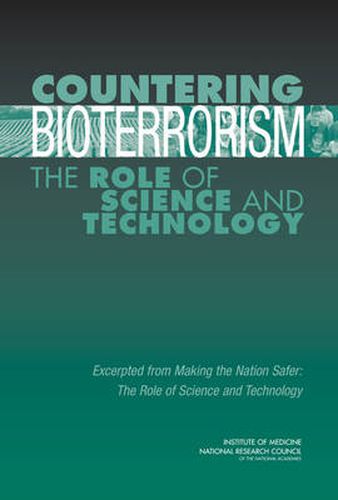Readings Newsletter
Become a Readings Member to make your shopping experience even easier.
Sign in or sign up for free!
You’re not far away from qualifying for FREE standard shipping within Australia
You’ve qualified for FREE standard shipping within Australia
The cart is loading…






The attacks of September 11 and the release of anthrax spores revealed enormous vulnerabilities in the U.S. public-health infrastructure and suggested similar vulnerabilities in the agricultural infrastructure as well. The traditional public health response-surveillance (intelligence), prevention, detection, response, recovery, and attribution-is the paradigm for the national response not only to all forms of terrorism but also to emerging infectious diseases. Thus, investments in research on bioterrorism will have enormous potential for application in the detection, prevention, and treatment of emerging infectious diseases that also are unpredictable and against which we must be prepared. The deciphering of the human genome sequence and the complete elucidation of numerous pathogen genomes, our rapidly increasing understanding of the molecular mechanisms of pathogenesis and of immune responses, and new strategies for designing drugs and vaccines all offer unprecedented opportunities to use science to counter bioterrorist threats. But these same developments also allow science to be misused to create new agents of mass destruction. Hence the effort to confront bioterrorism must be a global one. Countering Bioterrorism makes the following recommendations: Recommendation 1: All agencies with responsibility for homeland security should work together to establish stronger and more meaningful working ties between the intelligence, S&T, and public health communities. Recommendation 2: Federal agencies should work cooperatively and in collaboration with industry to develop and evaluate rapid, sensitive, and specific early-detection technologies. Recommendation 3: Create a global network for detection and surveillance, making use of computerized methods for real-time reporting and analysis to rapidly detect new patterns of disease locally, nationally, and ultimately- internationally. The use of high-throughput methodologies that are being increasingly utilized in modern biological research should be an important component of this expanded and highly automated surveillance strategy. Recommendation 4: Use knowledge of complex biological patterns and high-throughput laboratory automation to classify and diagnose infections in patients in primary care settings. Recommendation 5: USDA should create an agency for control and prevention of plant disease. This agency should have the capabilities necessary to deal effectively with biothreats.
$9.00 standard shipping within Australia
FREE standard shipping within Australia for orders over $100.00
Express & International shipping calculated at checkout
The attacks of September 11 and the release of anthrax spores revealed enormous vulnerabilities in the U.S. public-health infrastructure and suggested similar vulnerabilities in the agricultural infrastructure as well. The traditional public health response-surveillance (intelligence), prevention, detection, response, recovery, and attribution-is the paradigm for the national response not only to all forms of terrorism but also to emerging infectious diseases. Thus, investments in research on bioterrorism will have enormous potential for application in the detection, prevention, and treatment of emerging infectious diseases that also are unpredictable and against which we must be prepared. The deciphering of the human genome sequence and the complete elucidation of numerous pathogen genomes, our rapidly increasing understanding of the molecular mechanisms of pathogenesis and of immune responses, and new strategies for designing drugs and vaccines all offer unprecedented opportunities to use science to counter bioterrorist threats. But these same developments also allow science to be misused to create new agents of mass destruction. Hence the effort to confront bioterrorism must be a global one. Countering Bioterrorism makes the following recommendations: Recommendation 1: All agencies with responsibility for homeland security should work together to establish stronger and more meaningful working ties between the intelligence, S&T, and public health communities. Recommendation 2: Federal agencies should work cooperatively and in collaboration with industry to develop and evaluate rapid, sensitive, and specific early-detection technologies. Recommendation 3: Create a global network for detection and surveillance, making use of computerized methods for real-time reporting and analysis to rapidly detect new patterns of disease locally, nationally, and ultimately- internationally. The use of high-throughput methodologies that are being increasingly utilized in modern biological research should be an important component of this expanded and highly automated surveillance strategy. Recommendation 4: Use knowledge of complex biological patterns and high-throughput laboratory automation to classify and diagnose infections in patients in primary care settings. Recommendation 5: USDA should create an agency for control and prevention of plant disease. This agency should have the capabilities necessary to deal effectively with biothreats.